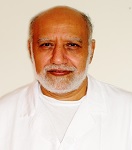
Magdy El-Salhy
Professor of Gastroenterology and Hepatology
Title: Intestinal endocrine cells as biomarkers for the diagnosis of irritable bowel syndrome
Biography
Biography: Magdy El-Salhy
Abstract
The diagnosis of Irritable Bowel Syndrome (IBS) in clinical practice is a diagnosis of exclusion, whereby diagnostic tests\r\nand invasive investigations are conducted to exclude other gastrointestinal diseases. Attempts have been made to achieve\r\na positive diagnosis based on symptoms assessment such as the Rome III criteria. However, symptom-based diagnosis is not\r\nwidely used in everyday clinical practice. Searches for biomarkers for the diagnosis of IBS that reflect pathological states have\r\nnot yielded any useful candidates. The duodenum contains the largest number of endocrine cells in the gastrointestinal tract,\r\nfollowed by the rectum. The densities of four of the five duodenal endocrine cell types have been found to be reduced in patients\r\nwith sporadic (non-specific) IBS. Chromogranin A (CgA) is a common marker for gastrointestinal endocrine cells. It has been\r\nthought that the cell density of CgA the duodenal endocrine cells, can be used as a biomarker for the diagnosis of IBS. Receiver\r\nOperator Characteristic (ROC) revealed areas under the ROC curve (ROCAUC) values of 0.97, and positive likelihood (+LH)\r\nand negative LR (-LH) of 18.5 and 0.14, respectively. This biomarker is simple, inexpensive, and easy to perform, and does not\r\nrequire sophisticated equipment or considerable experience. The density of PYY cells is reduced in the rectum of sporadic IBS\r\npatients, whereas that of somatostatin is increased. As biomarkers for the diagnosis of IBS, rectal PYY has a ROCAUC values\r\nof 0.96 and +LH and –LH 7.56 and 0.18, respectively. The corresponding values for somatostatin are 0.93, 7.20, and 0.23. These\r\nbiomarkers erform well in differentiating IBS from health and are better than Rome III criteria, which has +LH and –LH of\r\n3.53 and 0.39, respectively. Moreover, these biomarkers reflect an anatomical lesions occurring in the gastrointestinal tract of\r\nIBS patients, namely gastrointestinal endocrine cells.
